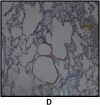Can IL-6 predict the development of fat embolism in polytrauma? A rabbit model pilot experimental study
- PMID: 31992925
- PMCID: PMC6976997
- DOI: 10.1016/j.jcot.2019.09.014
Can IL-6 predict the development of fat embolism in polytrauma? A rabbit model pilot experimental study
Erratum in
-
Erratum regarding previously published articles.J Clin Orthop Trauma. 2020 Nov-Dec;11(6):1169-1171. doi: 10.1016/j.jcot.2020.09.032. Epub 2020 Sep 26. J Clin Orthop Trauma. 2020. PMID: 33013141 Free PMC article.
-
Erratum regarding previously published articles.J Clin Orthop Trauma. 2020 Nov-Dec;11(6):1172-1174. doi: 10.1016/j.jcot.2020.10.044. Epub 2020 Oct 23. J Clin Orthop Trauma. 2020. PMID: 33192025 Free PMC article.
-
Erratum regarding previously published articles.J Clin Orthop Trauma. 2021 Aug 5;21:101557. doi: 10.1016/j.jcot.2021.101557. eCollection 2021 Oct. J Clin Orthop Trauma. 2021. PMID: 34414071 Free PMC article.
Abstract
Background: There are few studies in the literature that correlates the level of IL-6 with fat embolism syndrome (FES). But there is no conclusive correlative evidence of its specific relation to the establishment of FES. Also it is a proven fact that polytrauma due to its associated multiple long bone fracture and/or associated shock can predispose an individual to FES. By hypothesizing that polytrauma induces Fat Embolism in the animal; it was considered worthwhile to study the association of IL-6 in polytrauma induced Fat Embolism (FE) and to compare it with induced FE by injecting fatty acids in rabbits.
Materials and methods: An animal study was conducted in 32 New Zealand white rabbits. The animals were divided into 3 groups: control, fat embolism and polytrauma group. We injected 6 ml of normal saline and 0.2 ml of linoleic acid in the control and fat embolism group respectively. In the polytauma group we created bilateral femur and tibial shaft factures which were stabilized with intramedullary K- wires. Blood was taken before and at 6, 12 and 24 h after the procedure to measure plasma IL-6 levels. The rabbits were euthanized at 24 h and lungs were removed and stained for fat globules.
Results: All rabbits in the fat embolism group and around 72.22% rabbits in polytrauma group had fat embolism. The IL-6 levels were raised in all the groups reaching a peak at 6 h after procedure with a decline in the values at 12 h for polytrauma and fat embolism group. IL-6 in the control group was stationary after an initial raise at 6 h. There was no statistically significant difference seen among the groups (p value > 0.05) at 6 h.
Conclusion: IL-6 is not a specific marker to fat embolism per se or polytrauma who later develop complications like FES. Even though the recent literature says that IL-6 is an early marker of fat embolism, still the diagnosis of fat embolism syndrome is clinical only and can be supplemented by laboratory markers. None of the laboratory markers individually is good enough to predict the development of FES in an individual.
Keywords: Fat embolism; Interleukin 6; Polytrauma.
© 2019 Delhi Orthopedic Association. All rights reserved.
Figures











References
LinkOut - more resources
Full Text Sources
Miscellaneous

